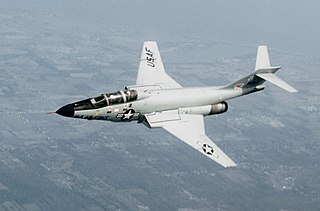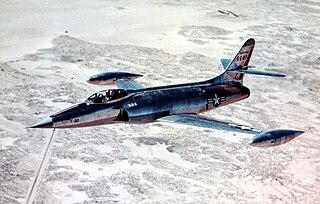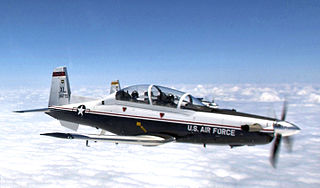Related Research Articles

An interceptor aircraft, or simply interceptor, is a type of fighter aircraft designed specifically for the defensive interception role against an attacking enemy aircraft, particularly bombers and reconnaissance aircraft. Aircraft that are capable of being or are employed as both ‘standard’ air superiority fighters and as interceptors are sometimes known as fighter-interceptors. There are two general classes of interceptor: light fighters, designed for high performance over short range; and heavy fighters, which are intended to operate over longer ranges, in contested airspace and adverse meteorological conditions. While the second type was exemplified historically by specialized night fighter and all-weather interceptor designs, the integration of mid-air refueling, satellite navigation, on-board radar and beyond visual range (BVR) missile systems since the 1960s has allowed most frontline fighter designs to fill the roles once reserved for specialised night/all-weather fighters.

The McDonnell F-101 Voodoo is a supersonic jet fighter which served the United States Air Force (USAF) and the Royal Canadian Air Force (RCAF).

The McDonnell XF-88 Voodoo was a long-range, twinjet fighter aircraft with swept wings designed for the United States Air Force. Although it never entered production, its design was adapted for the subsequent supersonic F-101 Voodoo.

The McDonnell XF-85 Goblin is an American prototype fighter aircraft conceived during World War II by McDonnell Aircraft. It was intended to deploy from the bomb bay of the giant Convair B-36 bomber as a parasite fighter. The XF-85's intended role was to defend bombers from hostile interceptor aircraft, a need demonstrated during World War II. McDonnell built two prototypes before the Air Force (USAAF) terminated the program.

The Century Series is a popular name for a group of US fighter aircraft representing models designated between F-100 and F-106 which went into full production. They included the first successful supersonic aircraft designs in the United States Air Force's service, which remained in active service well into the 1970s and 1980s with the Air Force Reserve and Air National Guard. Three later variants, the QF-100, QF-102 and QF-106, also continued in service, primarily as aerial target drones, until the late 1990s. The F-104G stayed in service with the Italian military until 2004. The NASA airborne science program maintains a group of F-104G in airworthy condition for use as test platforms and chase aircraft.

The North American XF-108 Rapier was a proposed long-range, high-speed interceptor aircraft designed by North American Aviation intended to defend the United States from supersonic Soviet strategic bombers. The aircraft would have cruised at speeds around Mach 3 with an unrefueled combat radius over 1,000 nautical miles, and was equipped with radar and missiles offering engagement ranges up to 100 miles (160 km) against bomber-sized targets.

The Tupolev Tu-28 was a long-range interceptor aircraft introduced by the Soviet Union in the 1960s. The official designation was Tu-128, but this designation was less commonly used in the West. It was the largest and heaviest fighter ever in service.

The Republic XF-103 was an American project to develop a powerful missile-armed interceptor aircraft capable of destroying Soviet bombers while flying at speeds as high as Mach 3. Despite a prolonged development, it never progressed past the mockup stage.

The Lockheed XF-90 was built in response to a United States Air Force requirement for a long-range penetration fighter and bomber escort. The same requirement produced the McDonnell XF-88 Voodoo. Lockheed received a contract for two prototype XP-90s. The design was developed by Willis Hawkins and the Skunk Works team under Kelly Johnson. Two prototypes were built. Developmental and political difficulties delayed the first flight until 3 June 1949, with Chief Test Pilot Tony LeVier at the controls. Embodying the experience gained in developing the P-80 Shooting Star, the XF-90 shared some design traits with the older Lockheed fighter, albeit with swept-wings; however, this latter design choice could not sufficiently make up for the project’s underpowered engines, and the XF-90 never entered production.

The North American F-107 is North American Aviation's entry in a United States Air Force tactical fighter-bomber design competition of the 1950s. The F-107 was based on the F-100 Super Sabre, but included many innovations and radical design features, notably the over-fuselage air intakes. The competition was eventually won by the Republic F-105 Thunderchief, and most of the F-107 prototypes ended their lives as test aircraft. One is on display at the National Museum of the United States Air Force and a second at Pima Air and Space Museum.

The Hughes AIM-4 Falcon was the first operational guided air-to-air missile of the United States Air Force. Development began in 1946; the weapon was first tested in 1949. The missile entered service with the USAF in 1956.

The McDonnell CF-101 Voodoo was an all-weather interceptor aircraft operated by the Royal Canadian Air Force and the Canadian Forces between 1961 and 1984. They were manufactured by the McDonnell Aircraft Corporation of St. Louis, Missouri for the United States Air Force, and later sold to Canada. CF-101s replaced the obsolete Avro CF-100 Canuck in the RCAF's all-weather fighter squadrons. The Voodoo's primary armament was nuclear AIR-2A Genie unguided air-to-air rockets, and there was significant political controversy in Canada about their adoption. Although they never fired a weapon in wartime, the CF-101 served as Canada's primary means of air defence from Quick Reaction Alert facilities at Canadian airbases. The CF-101s were retired in the 1980s and replaced with McDonnell Douglas CF-18 Hornet fighters. Many examples are preserved in museums and parks in Canada and the United States.

The escort fighter was a concept for a fighter aircraft designed to escort bombers to and from their targets. An escort fighter needed range long enough to reach the target, loiter over it for the duration of the raid to defend the bombers, and return.

Aerospace Defense Command was a major command of the United States Air Force, responsible for continental air defense. It was activated in 1968 and disbanded in 1980. Its predecessor, Air Defense Command, was established in 1946, briefly inactivated in 1950, reactivated in 1951, and then redesignated Aerospace rather than Air in 1968. Its mission was to provide air defense of the Continental United States (CONUS). It directly controlled all active measures, and was tasked to coordinate all passive means of air defense.
WS-201A, informally known as the 1954 Interceptor, was a United States Air Force project to develop a dedicated interceptor aircraft that would enter service in 1954. Several aircraft were developed as part of the project, leading to the F-102 Delta Dagger, F-106 Delta Dart, Republic XF-103 and, indirectly, the F-101B Voodoo and F-104 Starfighter. The electronics and weapons developed for the program would become common on US designs, including the AIM-4 Falcon missile and a variety of Hughes Aircraft-supplied radar and fire control systems. The project also led, eventually, to the upgrading of the SAGE battle control computers to directly control the interceptors for much of their flight. Although greatly delayed, the resulting systems operated for approximately 20 years, into the 1980s.

The 62d Fighter Squadron is part of the United States Air Force 56th Operations Group at Luke Air Force Base, Arizona. It operates the Lockheed Martin F-35A Lightning II aircraft conducting advanced fighter training.

The 84th Flying Training Squadron is part of the United States Air Force 47th Flying Training Wing based at Laughlin Air Force Base, Texas. It operates Beechcraft T-6 Texan II aircraft conducting flight training.

The 322d Fighter-Interceptor Squadron is an inactive United States Air Force unit. Its last assignment was with the 408th Fighter Group at Kingsley Field, Oregon, where it was inactivated on 1 July 1968.

The 92d Cyberspace Operations Squadron is a United States Air Force unit.

A strategic fighter is a fast, well-armed and long-range fighter aircraft, capable of fulfilling roles such as that of an escort fighter protecting bombers, a penetration fighter carrying out offensive sorties of its own far into enemy territory, and of maintaining standing combat air patrols at significant distance from its home base.
References
- ↑ "USAF Air Materiel Command Design 938A Penetration Fighter Study of 1948"
- ↑ "F-101 'Voodoo'", globalsecurity.org (retrieved 22 January 2020): "In 1953, AAC altered the requirement to a strategic fighter capable of delivering nuclear weapons, causing diversions, and fighting off enemy interceptors. McDonnell Aircraft corporation redesigned the XF-88 to carry larger engines, lengthened the fuselage to provide additional fuel storage, and submitted its strategic fighter proposal. The new aircraft, designated the F-101A, was the first Air Force fighter designed to be supersonic."
- ↑ Green & Swanborough (1994), p.367: "Evolved from the XF-88 by a team led by E M Flesh as a deep penetration escort fighter, the Voodoo..."
- ↑ Robert Lyons Jr., "The Search For An Advanced Fighter", US Air Force Air Command and Staff College, 1986
- ↑ "Fact Sheet: North American F-108A Rapier" Archived 2014-12-28 at the Wayback Machine , National Museum of the United States Air Force